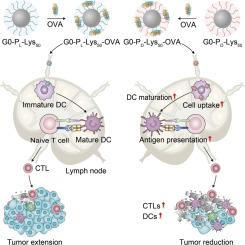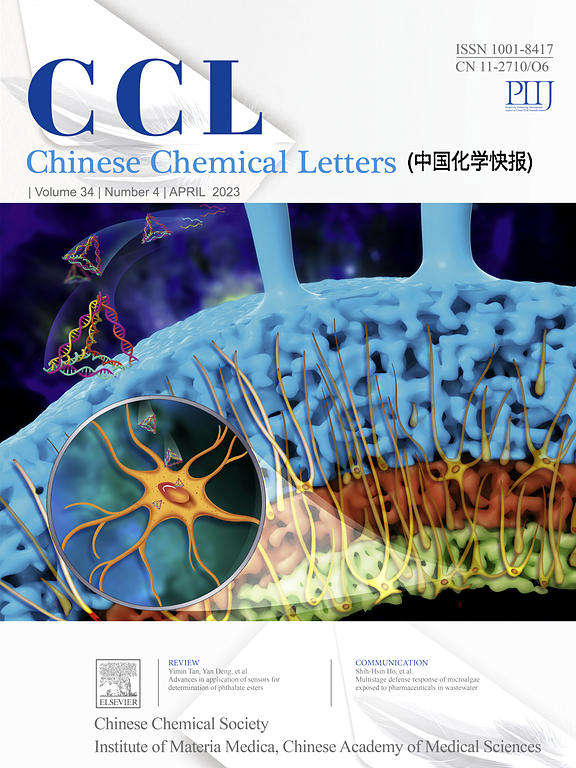单分子手性聚氨基酸作为增强肿瘤免疫治疗纳米疫苗的佐剂
IF 8.9
1区 化学
Q1 CHEMISTRY, MULTIDISCIPLINARY
引用次数: 0
摘要
手性是普遍存在的,在生物过程中起着至关重要的作用。尽管氨基酸具有固有的手性,但这种特性对免疫细胞调节的立体化学影响仍未得到充分探讨。为了解决这一问题,我们合成了单分子手性聚氨基酸,以评估其免疫刺激作用和抗癌潜力。在候选药物中,通过体外筛选,G0-PD-Lys50成为最有效的佐剂。当与抗原卵清蛋白(OVA)络合形成手性纳米疫苗时,G0-PL-Lys50-OVA和G0-PD-Lys50-OVA表现出相似的形态、粒径和zeta电位。尽管具有这些相似的物理化学性质,但G0-PD-Lys50-OVA诱导的树突状细胞(DCs)的活化明显更强。具体来说,它导致淋巴结中CD11c+CD80+ dc和CD11c+SIINFEKL-H-2Kb+ dc分别增加1.38倍和1.34倍。在LLC-OVA癌症模型中,G0-PD-Lys50-OVA比其对映体减少了50% %的肿瘤体积。这些结果建立了一种设计手性纳米疫苗的独特方法,并为开发广泛应用的免疫疗法提供了基础策略。本文章由计算机程序翻译,如有差异,请以英文原文为准。

Unimolecular chiral poly(amino acid)s as adjuvants of nanovaccines for augmented cancer immunotherapy
Chirality is pervasive and plays a crucial role in biological processes. Although amino acids possess inherent chirality, the stereochemical influence of this property on the regulation of immune cells remains insufficiently explored. To address this, the unimolecular chiral poly(amino acid)s were synthesized to evaluate their immunostimulatory effects and anti-cancer potential. Among the candidates, G0-PD-Lys50 emerged as the most effective adjuvant through in vitro screening. When complexed with antigen ovalbumin (OVA) to form chiral nanovaccines, G0-PL-Lys50-OVA and G0-PD-Lys50-OVA exhibited similar morphology, particle size, and zeta potential. Despite these comparable physicochemical properties, G0-PD-Lys50-OVA induced significantly stronger activation of dendritic cells (DCs). Specifically, it resulted in 1.38 and 1.34-fold increases in CD11c+CD80+ DCs and CD11c+SIINFEKL-H-2Kb+ DCs in lymph nodes, respectively. In the LLC-OVA cancer model, G0-PD-Lys50-OVA reduced tumor volume by 50 % compared to its enantiomer. These results establish a unique approach to designing chiral nanovaccines and provide a foundational strategy for developing broadly applicable immunotherapies.
求助全文
通过发布文献求助,成功后即可免费获取论文全文。
去求助
来源期刊

Chinese Chemical Letters
化学-化学综合
CiteScore
14.10
自引率
15.40%
发文量
8969
审稿时长
1.6 months
期刊介绍:
Chinese Chemical Letters (CCL) (ISSN 1001-8417) was founded in July 1990. The journal publishes preliminary accounts in the whole field of chemistry, including inorganic chemistry, organic chemistry, analytical chemistry, physical chemistry, polymer chemistry, applied chemistry, etc.Chinese Chemical Letters does not accept articles previously published or scheduled to be published. To verify originality, your article may be checked by the originality detection service CrossCheck.
 求助内容:
求助内容: 应助结果提醒方式:
应助结果提醒方式:


